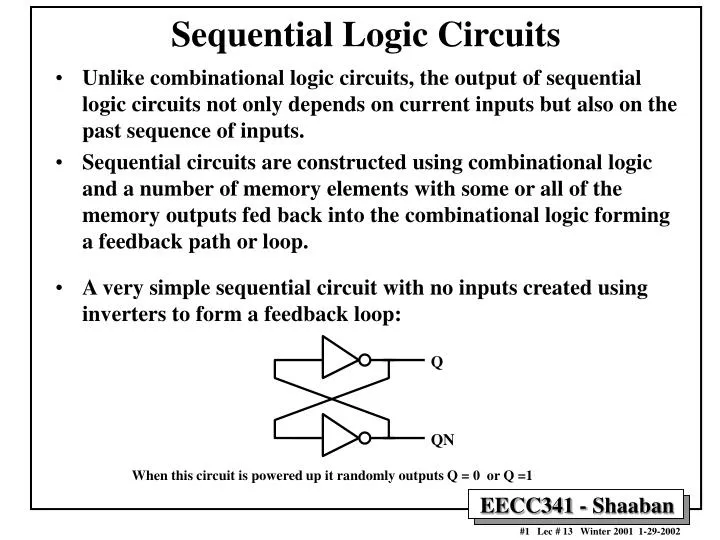
That is, sequential logic has state (memory) while combinational logic does not. This is in contrast to combinational logic, whose output is a function of only the present input. In automata theory, sequential logic is a type of logic circuit whose output depends on the present value of its input signals and on the sequence of past inputs, the input history. What happened to the output this time? This test is actually setup to demonstrate a race condition.Wikipedia Rate this definition: 0.0 / 0 votes Now modify the circuit again according to Fig. Observe the output, especially when input changes from 1 to 0. Connect data switch SW1 to a pulse generator. Now modify the S-R flip-flop according to Fig. Experiments 3.1 Flip-Flopsīuild an S-R flip-flop using NOR gates. Students are expected to understand basic sequential circuits and the ways to measure delay time and set-up time of sequential logic circuits. This lab introduces the concept of sequential logic circuits and their basic working mechanisms.

For example, set-up time for a D flip-flop is defined as the time required for the data to be present (above, or below, a threshold value) on the input before the clock transition (edge) occurs. Set-up time for flip-flops is defined as the time interval during which a signal must be applied and maintained at a specific input terminal before an active transition occurs at the clock input. In logic circuit design, this condition should be avoided by making sure that 1's are not applied to both inputs simultaneously. 1 are changed from logic 1 to logic 0 at the same time, its outputs will be unpredictable and we call that a race condition. If both inputs to the S-R flip-flop in Fig. If the difference in time is sufficiently large, the counter might just loop between 00 and 01 forever, never reaching 10 and 11. But what happens if the most significant bit changes faster than the least significant bit? In this case, the sequence would go from 00 to 01 and then to 00.

The most significant bit would change from 0 to 1 and the least significant bit would change from 1 to 0. Consider a simple 2-bit counter that goes through the sequence 00, 01, 10, 11, 00, … When the value is 01, we want the counter to change to 10 next. Note that a negative logic signal such as R is considered asserted (logicalĪ race condition can occur when two values are supposed to change simultaneously, but one may actually be quicker than the other. Table 1 shows the truth tables for both cases. An S-R flip-flop can also be design using cross-coupled NAND gates as shown in Fig. S-R FIip-Flop:Īn S-R latch consists of two cross-coupled NOR gates and possibly two inverters, as shown in Fig. Some of the most widely used latches are listed below. State variables which change only between logic 1 and logic 0 are called binary state variables. Usually there are two outputs, Q and its complementary value.

The latch (flip-flop) is a basic bi-stable memory element widely used in sequential logic circuits.
#Sequential logic diagram generator
Sequential logic circuits often require a timing generator (a clock) for their operation. Logic circuits that incorporate memory cells are called sequential logic circuits their output depends not only upon the present value of the input but also upon the previous values.

Their usage in digital circuits provides temporary storage of the outputs produced by a combinational logic circuit for use at a later time in the operation of a digital system. Memory cells are very important in digital systems. These circuits do not have memory cells and their output depends only upon the current value of the input. In the last experiment, the logic circuits introduced were combinational.


 0 kommentar(er)
0 kommentar(er)
